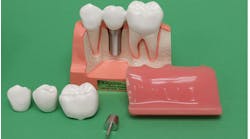Dentistry is a profession with high physical and mental demands. Statistics show that there is a high incidence of musculoskeletal injuries, as well as mental fatigue, due to the characteristics of the work and its dynamics.1 Ergonomics and human factors are widely applied sciences in industrial and office jobs. Static sitting postures are proven risk factors for skeletal muscle injuries.
Here I share a different perspective to obtain better performance in dental work that focuses on efficiency and the health of the operator, based on four pillars of dental ergonomics.
- The knowledge and application of body biomechanics in dental work
- The use of an ergonomic chair
- The use of a dental microscope
- Applying four-handed work with a dental assistant
The integration of these pillars will immediately impact the design and work method of the office, and not using any of them will diminish the full effect of ergonomic practice. I’ll analyze each factor and why they’re essential for long-term success in dental practice.
You might also be interested in: Poor ergonomics in dentistry: How to keep (or save) your career
Biomechanics of the body knowledge and application
The cornerstone of dental practice is how we use our body for static, seated, and high mental demand work. The three risk factors for developing musculoskeletal disorders are pain, injuries, and mental and muscular fatigue, which have an immediate impact on the performance and quality of the dental procedure.
The statistics of musculoskeletal disorders in dentists and hygienists are between 64% and 93%,2 and there’s a high percentage of early retirement rates due to disability—14% before age 45 due to the profession’s risk factors.3 These include uncomfortable postures, seated posture, prolonged static posture, repetition of movements, high demand for precision in the treatment, and high organizational demand.
The most determining factor physically is the disruption of the natural curves of the dorsal spine added to the modifying factors, duration and frequency. The cervical and lumbar curves have the most significant exposure to the most decisive injuries in the profession. Hence the highest rates of injury among dentists are in these areas.4
The cervical and lumbar are considered fulcrum points from which the dental clinician leans forward to observe the oral cavity and manage treatments in a dark and small area where the eye is limited in visual capacity and resolution. Forward postures coupled with twisting and lateral bending generate compressive forces on the spinal discs and overwork the abdominal and back postural muscles to counteract the stress of such nonneutral postures.
The position of the operator when working does or does not promote postural deviation. The most stable postural symmetry, since it is closer to the body's axis, is behind the patient's head at 12 o'clock. The greater the lateral positioning of the operator, at 9 or 10 o'clock, the greater the deviation in the neutral posture and the more significant the musculoskeletal fatigue in the upper limb, neck, and back. Using a mirror has been shown to improve operator posture.
It’s essential to learn what the neutral posture of sitting work is like. A simple way to apply this is the side view shown in figure 1. Postural awareness when working, and always thinking about this recommended posture while using a positioning sequence, can generate key physical improvements and extend the clinician’s life.
The ergonomic stool
From an ergonomic point of view, the most important chair is the operator's chair. Understand that the patient will temporarily be in the dental chair while the operator poses for long periods of time during the day, weeks, and years. The acquisition of an ergonomic chair should be important. Contemporary ergonomic chairs have smart designs whose purpose is to support structures that need it.5
What should you look for in an ergonomic chair? The seat must provide a necessary negative inclination that protects the pelvis, which is the foundation of the body while sitting. There is a misconception that we should sit with the pelvis at 90 degrees. This actually wrongly places the pelvis and leads to lumbar curvature in compressive loads prolonged during the day. On the contrary, the seat with the possibility of negative inclination places the pelvis at 110 to 125 degree angles (if it is a saddle seat), protecting the lumbar curvature immediately.
Lumbar support is equally important to maintain the lumbar curve and prevent fatigue of the postural muscles of the back. The armrest plays an essential role in supporting the upper extremities and shoulders, trapezius, and neck. Consider that the weight of the arms is 5% of the total body weight and equally important for fine motor skill work and precision in dental work.
The chair must be adjustable in height and width to standardize its use to different body dimensions. Also, select it according to personal taste and individual measurements (figure 2).
The dental microscope
High-magnification tools play an important role in improving treatment quality by allowing the operator to see the work field better. However, the surgical optical microscope is the tool with the most ergonomic features. 6 Loupes with view deflection angles promote good posture. They have a magnification possibility also, but with limits on multiple magnification steps and light sources with shadows in the field of view.
The dental microscope solves the lack of shadow-free lighting and allows the visual field of work to be increased with five to six magnification steps. Due to the working distance set in its objective, it enables the operator to work upright, with the head in neutral position more than 50 cm from the patient's mouth.
Most of the operator’s postural problems lie in the limits of the human eye. Its forces a tilt of the trunk and the head forward to focus on the mouth and tooth, which is solved by using a microscope. Elements such as the rotary ring, the binocular extender, and the variofocus objective are accessories of the microscope that allow working in areas of difficult access in the mouth without rotating or tilting the head. This keeps the head in a neutral posture, and versatility in working distances alleviates the learning curve of the microscope.
It’s fascinating how a single device can correct the operator's posture and improve the magnification in multiple steps, solving the problem of the visual limitation of the human eye in terms of focal length. The dental microscope is an essential aspect of the training stage in dental school to create postural awareness early in future professionals.
Four-handed work with a dental assistant
The support of a well-trained assistant is essential for an operator's 100% efficient, healthy, and fluid work.7 Without a well-trained assistant, the operator cannot control their visual field while they’re working, which is essential to perform at their best and avoid mental and physical fatigue. Teaching the assistant to handle everything outside the patient's mouth and to place the instruments and equipment in frequent use in the operator's hands is essential to gain efficiency and workflow.
To ensure correct work by the assistant, they must: (figure 3)
- Have the same neutral working posture recommended for the operator
- Sit on a stool on the patient's left side with their thigh parallel to the patient's left shoulder and mouth
- Sit with the eyes at the same level or higher than the operator's eyes to have better view angles and less forward leaning
- Keep the instruments and equipment of frequent use in front of them and be able to hand everything quickly and safely to the operator, while also protecting the body
Editor's note: This article appeared in the June 2023 print edition of Dental Economics magazine. Dentists in North America are eligible for a complimentary print subscription. Sign up here.
References
- Moodley R, Naidoo S, van Wyk J. The prevalence of occupational health-related problems in dentistry: a review of the literature. J Occup Health.2018;60(2):111–125. doi:10.1539/joh.17-0188-RA
- Hayes MJ, Smith DR, Cockrell D. An international review of musculoskeletal disorders in the dental hygiene profession. Int Dent J. 2010;60(5):343–352.
- Gupta A, Bhat M, Mohammed T, Bansal N, Gupta G. Ergonomics in dentistry. Int J Clin Pediatr Dent.2014;7(1):30–34. doi:10.5005/jp-journals-10005-1229
- Kett AR, Sichting F, Milani T. The effect of sitting posture and postural activity on low back muscle stiffness. Biomechanics.2021;1(2):214–224. doi.10.3390/biomechanics1020018
- Garcia-Vidal JA, Lopez-Nicolas M, Sanchez-Sobrado AC, et al. The combination of different ergonomic supports during dental procedures reduces the muscle activity of the neck and shoulder. J Clin Med.2019;8(8):1230. doi:10.3390/jcm8081230
- Bud M, Jitaru S, Lucaciu O, et al. The advantages of the dental operative microscope in restorative dentistry. Med Pharm Rep.2021;94(1):22–27. doi:10.15386/mpr-1662
- Dalai DR, Bhaskar DJ, Gupta V, et al. Four handed dentistry: an indispensable part for efficient clinical practice. Int J Advanced Health Sci. 2014;1(1):16–20. https://www.researchgate.net/publication/262873221_Four_Handed_Dentistry_An_Indispensable_Part_for_Efficient_Clinical_Practice









